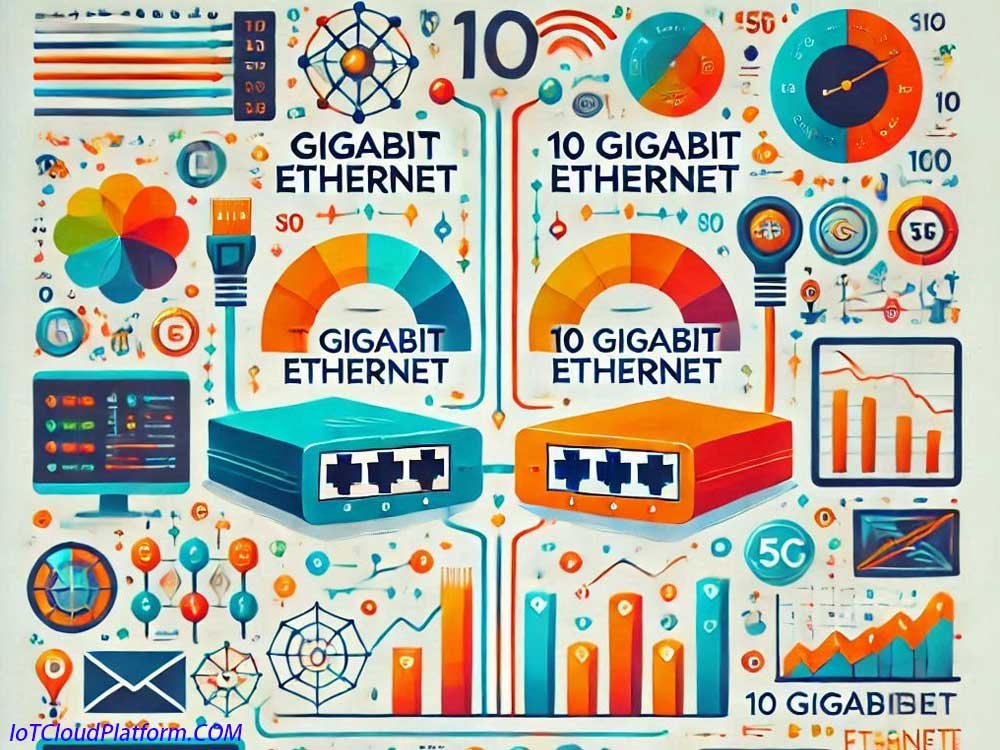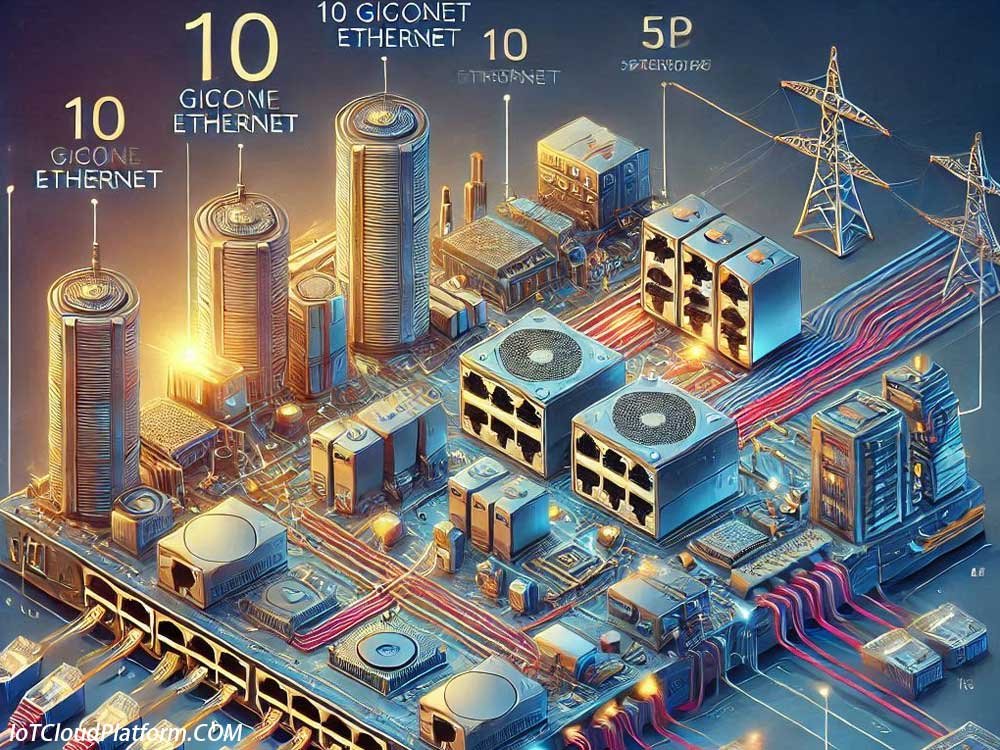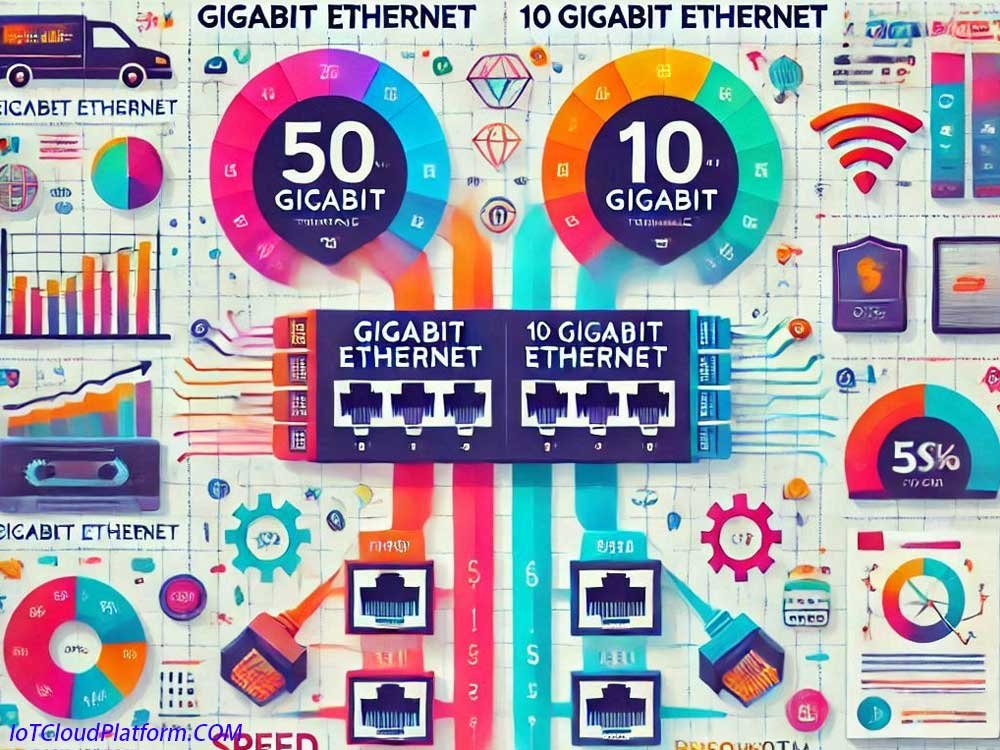
Gigabit Ethernet or 10 Gigabit Ethernet for IoT Projects?
In IoT projects, whether to choose Gigabit Ethernet or 10 Gigabit Ethernet depends on multiple factors, including the specific needs of the project, budget, technical compatibility, future scalability, and network traffic.
The following is a detailed introduction to Gigabit Ethernet and 10 Gigabit Ethernet, as well as their respective application considerations in IoT projects.
Gigabit Ethernet
1. Overview
Gigabit Ethernet is a network transmission standard with a transmission rate of 1Gbps (gigabit per second). It is built on the basic Ethernet standard and is fully compatible with the widely used Ethernet and Fast Ethernet, and retains all technical specifications specified by these standards, such as CSMA/CD protocol, Ethernet frame format, full-duplex transmission, flow control, etc.
2. Technical features
- High efficiency: Gigabit Ethernet provides high-speed data transmission capabilities, which can meet the needs of real-time transmission of large amounts of data in IoT projects.
- Compatibility: Compatible with existing Ethernet and Fast Ethernet technologies, without the need for large-scale transformation of network infrastructure.
- Scalability: Supports a variety of transmission media, such as optical fiber, twisted pair, etc., which can be flexibly selected according to project requirements.
- Stability: Adopts mature Ethernet technology, with high stability and reliability.
3. Application scenarios
- Enterprise network: In the internal LAN of large enterprises, Gigabit Ethernet can greatly improve the efficiency of data transmission and meet the needs of daily office, file sharing, video conferencing, etc.
- Data center: Supports large-scale data transmission and processing, providing users with efficient services. With the increasing popularity of cloud computing and big data technology, Gigabit Ethernet has become one of the indispensable infrastructures of data centers.
- Smart home: With the popularity of smart homes, Gigabit Ethernet can be used to achieve high-speed communication between smart devices and improve the performance and stability of home networks.
4. Limitations
Although Gigabit Ethernet has many advantages, its transmission rate may not be sufficient to meet the requirements in some IoT projects with high bandwidth requirements. In addition, with the development of IoT technology and the increase in IoT devices, network traffic will continue to increase, and Gigabit Ethernet may face bandwidth bottleneck problems.
10 Gigabit Ethernet
1. Overview
10 Gigabit Ethernet is a network transmission standard with a transmission rate of 10Gbps (10 Gigabits per second). It is an upgraded version of Gigabit Ethernet, providing higher bandwidth and stronger data transmission capabilities.
2. Technical Features
- High bandwidth: 10 Gigabit Ethernet provides a transmission rate of 10Gbps, which is 10 times that of Gigabit Ethernet, and can meet the application scenarios with extremely high bandwidth requirements in IoT projects.
- Full-duplex transmission: All data transmission is carried out in full-duplex mode, which greatly expands the coverage area of the network and simplifies the standards.
- Multiple fiber interfaces: Depending on the application scenario, 10 Gigabit Ethernet defines a variety of fiber interfaces (such as 10GBASE-SR, 10GBASE-LR, 10GBASE-ER, etc.) to adapt to different transmission distances and fiber media.
- Flexibility: Supports a variety of transmission media and topologies, and can be flexibly configured according to project requirements.
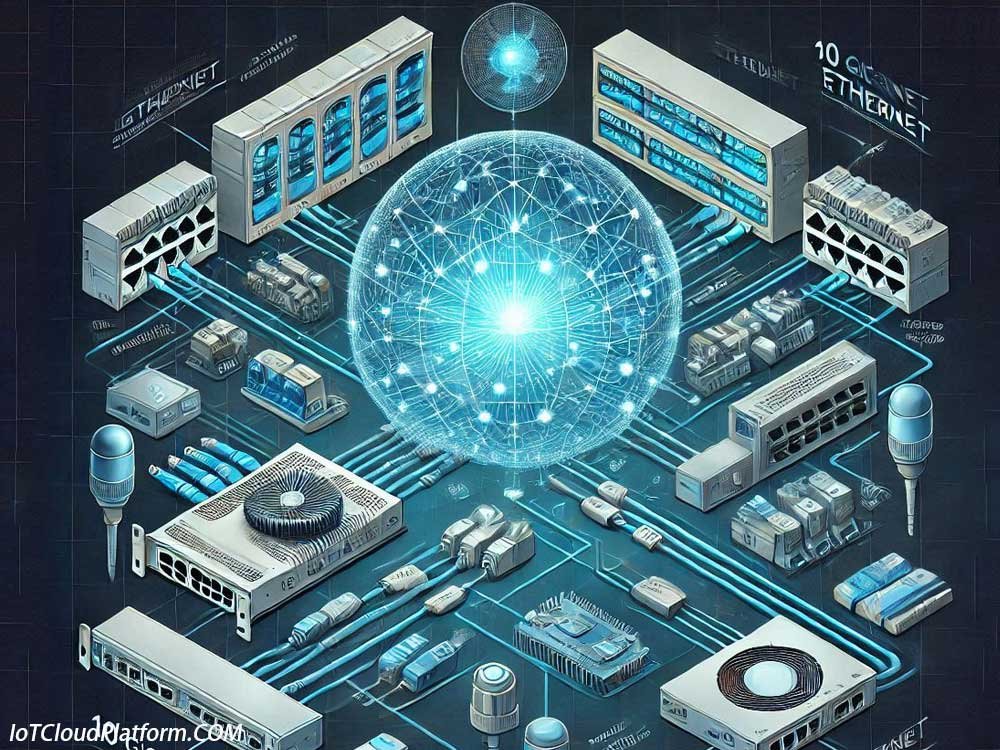
3. Application scenarios
- Large-capacity data transmission: In IoT projects, when large amounts of data need to be transmitted (such as high-definition video streams, large-scale sensor data, etc.), 10 Gigabit Ethernet can provide sufficient bandwidth support.
- High-performance computing: In high-performance computing environments, 10 Gigabit Ethernet can be used to connect servers, storage devices, and network devices to achieve high-speed data transmission and resource sharing.
- Metropolitan area network and wide area network: 10 Gigabit Ethernet technology can be applied to the construction of metropolitan area network and wide area network, allowing LAN technology to compete with ATM or other wide area network technologies. It can achieve end-to-end Ethernet connection, avoid bandwidth waste, and provide high-quality services and effective traffic control.
4. Development trend
With the continuous development of IoT technology, more and more IoT projects will require higher bandwidth and stronger data transmission capabilities. Therefore, 10 Gigabit Ethernet has broad application prospects in future IoT project engineering. At the same time, with the continuous advancement of technology and the reduction of costs, 10 Gigabit Ethernet will become more popular and easier to use.
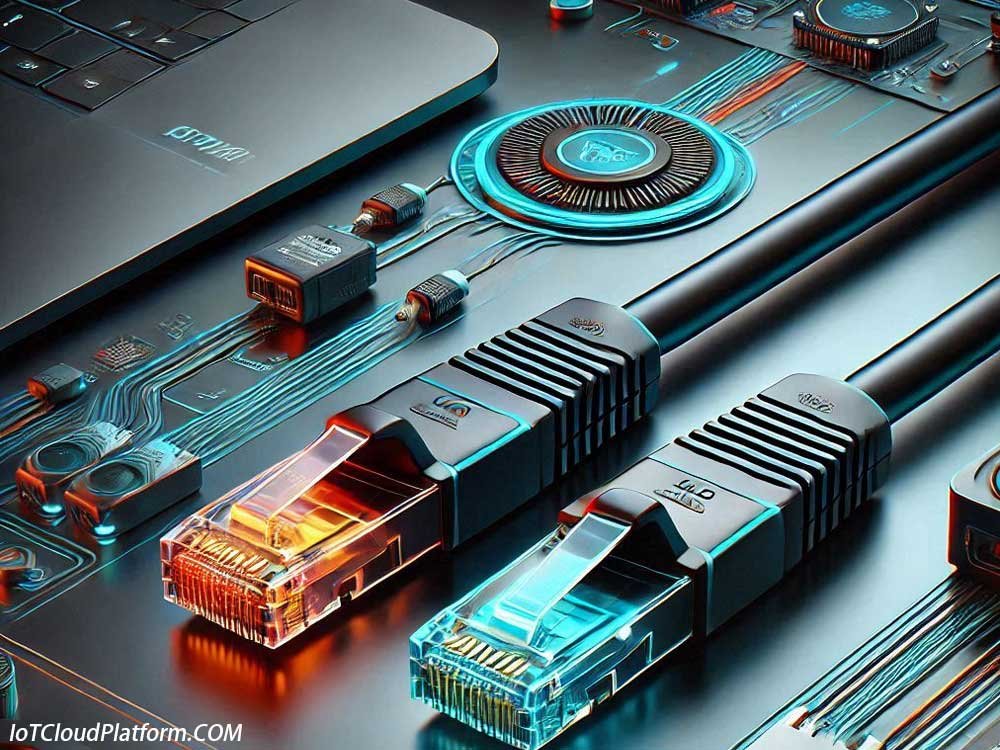
Gigabit Ethernet vs. 10 Gigabit Ethernet
When choosing between Gigabit Ethernet and 10 Gigabit Ethernet, the following factors need to be considered:
1. Project requirements
First, it is necessary to clarify the specific requirements of the IoT project, including data transmission volume, real-time requirements, bandwidth requirements, etc. If the project needs to transmit a large amount of data or has high bandwidth requirements, 10 Gigabit Ethernet should be considered; if the project requirements are relatively low, Gigabit Ethernet is an economical and practical choice.
2. Budget
Budget is one of the key factors in choosing network technology. The cost of 10 Gigabit Ethernet is usually higher than that of Gigabit Ethernet, including the cost of hardware equipment, wiring, installation and maintenance. Therefore, with a limited budget, it is necessary to weigh the actual needs and economic feasibility of the project.
3. Technical compatibility
When choosing network technology, it is necessary to consider compatibility with existing equipment and systems. Gigabit Ethernet is compatible with existing Ethernet and Fast Ethernet technologies, and does not require large-scale transformation of network infrastructure. 10 Gigabit Ethernet requires corresponding hardware equipment and wiring support. Therefore, when choosing, it is necessary to evaluate the compatibility of existing equipment and systems and future scalability.
4. Future scalability
With the development of IoT technology and the increase in IoT devices, network traffic will continue to increase. Therefore, future scalability needs to be considered when choosing network technology. 10 Gigabit Ethernet has higher bandwidth and stronger data transmission capacity, which can better meet the development needs of future IoT projects. Although Gigabit Ethernet may meet the needs at the current stage, it may face bandwidth bottleneck problems in the future.
Network design in IoT project engineering
Network design is a crucial link in IoT project engineering. Here are some suggestions:
1. Requirements analysis
Before the project starts, a detailed requirements analysis is required to clarify the goals, scope, functional requirements, etc. of the project. This helps to determine the direction and focus of network design.
2. Network topology
Choose a suitable network topology according to the needs and actual situation of the project. Common network topologies include star, bus, ring, etc. In IoT projects, star topology is usually more commonly used because it has the advantages of easy management and good scalability.
3. Transmission medium selection
Choose a suitable transmission medium according to the needs and actual situation of the project. In IoT projects, optical fiber is usually a better choice because it has the advantages of high speed, long-distance transmission, and strong anti-interference ability. At the same time, other transmission media such as twisted pair can also be considered.
4. Network equipment selection
Select appropriate network equipment according to project requirements and budget. This includes switches, routers, firewalls, etc. When selecting, factors such as equipment performance, compatibility, and scalability need to be considered.
5. Network security design
Network security is crucial in IoT projects. Effective network security strategies need to be designed, including access control, encryption technology, firewalls, etc. At the same time, regular security checks and vulnerability scans of the network are required to ensure the security of the network.
6. Network performance testing
After the network design is completed, network performance testing is required. This includes bandwidth testing, delay testing, packet loss rate testing, etc. Testing can evaluate the performance and stability of the network and ensure that the network can meet the needs of the project.
Network optimization in IoT project engineering
In IoT project engineering, network optimization is an important means to improve network performance and stability. Here are some suggestions:
1. Traffic control
Through reasonable traffic control strategies, problems such as network congestion and data loss can be avoided. This includes using traffic shaping technology, priority setting and other means to optimize network traffic.
2. Load balancing
Load balancing technology can disperse network traffic to multiple network devices or links, thereby improving network throughput and reliability. In IoT projects, load balancers can be used to achieve this function.
3. Redundancy design
Redundancy design is an important means to improve network reliability. By adding redundant devices and links to the network, fast switching and recovery can be achieved when a device or link fails. This helps to ensure the continuity and stability of IoT projects.
4. Network monitoring and management
Through effective network monitoring and management means, the operating status and performance indicators of the network can be understood in real time. This helps to promptly discover and solve network problems and improve network reliability and stability. At the same time, the network can also be optimized and adjusted to adapt to changes in project requirements.
Summary
In IoT projects, the choice of Gigabit Ethernet or 10 Gigabit Ethernet needs to be considered comprehensively based on the specific needs, budget, technical compatibility and future scalability of the project.
Gigabit Ethernet has the advantages of high efficiency, compatibility, scalability and stability, and is suitable for most IoT projects; while 10 Gigabit Ethernet provides higher bandwidth and stronger data transmission capabilities, and is suitable for IoT projects with high bandwidth requirements.
In terms of network design and optimization, it is necessary to pay attention to issues such as demand analysis, network topology, transmission medium selection, network equipment selection, network security design and network performance testing.
Through reasonable network design and optimization methods, the network performance and stability of IoT projects can be improved, providing strong support for the development of IoT technology.
About IoT Cloud Platform Factory
IOT Cloud Platform (blog.iotcloudplatform.com) focuses on IoT design, IoT programming, security IoT, industrial IoT, military IoT, best IoT projects, IoT creativity, IoT companies, Chinese IoT companies, American IoT companies, top IoT companies, IoT modules, embedded development, IoT circuit boards, IoT solutions, Raspberry Pi development and design, Arduino programming, programming languages, RFID, lora devices, IoT systems, sensors, temperature and humidity sensors, liquid level sensors, sensor devices, artificial intelligence, blockchain, robotic arms, smart homes, smart cities, smart agricultural factories, edge computing, big data, cloud computing, brain-computer interfaces, machine learning, robots, VR/AR, AI simulation technology, motion control, new energy, photovoltaic solar energy, lithium batteries, RFID, silicon brain SBB, unmanned aerospace navigation, unmanned driving, AGI, chips, semiconductors, smart hardware and other scientific and technological knowledge. If you need to cooperate with us, please contact us.
IoT Cloud Platform focuses on sharing technical knowledge of IoT + new technology. We can write professional IoT articles for you; at the same time, IoT Cloud Platform undertakes advertising alliance cooperation.
FAQs
The main difference between Gigabit Ethernet and 10 Gigabit Ethernet is the data transmission rate. The data transmission rate of Gigabit Ethernet is 1Gbps, while the data transmission rate of 10 Gigabit Ethernet is 10Gbps, and the latter has higher bandwidth and faster transmission speed.
Whether to choose Gigabit Ethernet or 10 Gigabit Ethernet depends mainly on the specific needs of the IoT project. If the project needs to process a large amount of data, support high concurrent access, or require high-speed data transmission, then 10 Gigabit Ethernet may be more suitable. On the contrary, if the project is small, the data volume is not large, or the budget is limited, Gigabit Ethernet is a more economical choice.
Although Gigabit Ethernet has a high data transmission rate, it does not necessarily meet the needs of all IoT projects. Especially for IoT projects that need to process a large amount of real-time data, support high concurrent access, or require high-speed data transmission, Gigabit Ethernet may become a bottleneck.
The advantages of 10 Gigabit Ethernet in IoT projects are mainly reflected in higher bandwidth and faster transmission speed. This ensures that the data in the IoT project can be transmitted and processed in real time and accurately, thereby improving the efficiency and reliability of the entire system.
Generally speaking, the deployment cost of 10 Gigabit Ethernet is higher than that of Gigabit Ethernet. This is mainly because 10 Gigabit Ethernet requires higher-performance network equipment and more complex network architecture to support its high-speed data transmission. However, with the continuous advancement of technology and the reduction of costs, the deployment cost of 10 Gigabit Ethernet is also gradually decreasing.
Both Gigabit Ethernet and 10 Gigabit Ethernet have good compatibility. They can be seamlessly integrated with existing network devices, operating systems, and applications to ensure the smooth deployment and operation of IoT projects.
In IoT projects, if the budget is limited, Gigabit Ethernet can be selected as the starting point, and gradually upgraded to 10 Gigabit Ethernet as the project develops and demand grows. If the budget is sufficient and the project requires high bandwidth and high-speed data transmission, then 10 Gigabit Ethernet can be directly selected to ensure the smooth progress of the project.
